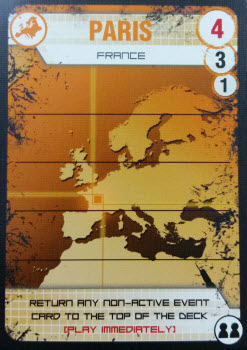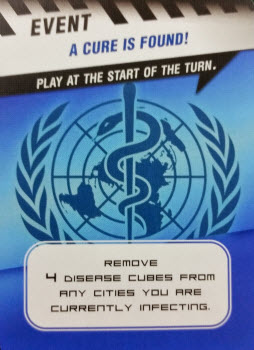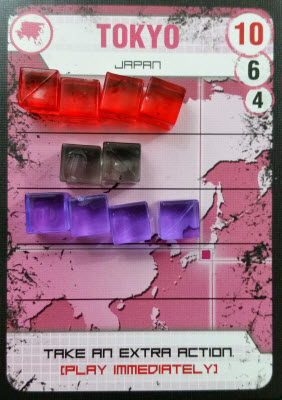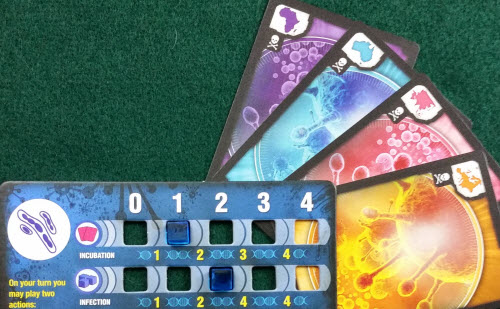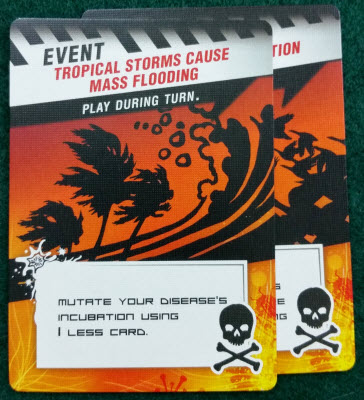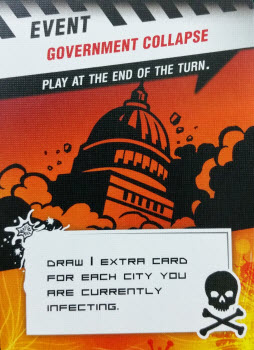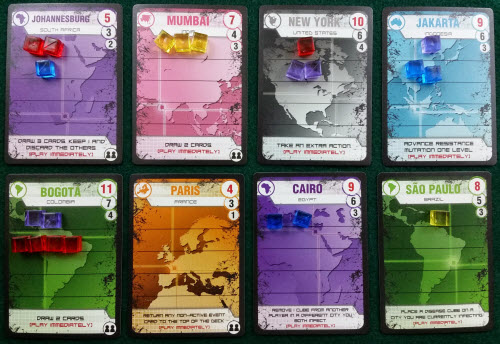All things considered, humans had it pretty easy compared to the rest of the natural world. Sure, a shark or lion occasionally got lucky, but for the most part, humans were on top of the top of the food chain. We did what we wanted, went where we wanted, and we reshaped our surroundings when we got there. We were pretty sure the only thing that would stop us, short of an invasion of little green space men, was ourselves.
We were wrong.
The Premise
Humanity has proven too problematic, and it is high time that they be wiped out. In this game of spreading disease rather than preventing it, players portray different pandemic illnesses whose goals are to multiply and decimate as many human cities as possible while avoiding the prevention efforts of the stalwart World Health Organization.
The Rules
In this deadly card game, the goal of Contagion is, predictably, to infect the world. Conveniently, setup is quicker than mitosis, as the game consists mostly of three card sets, being Contagion, City, and Event / WHO Cards.
To begin, 6-10 City cards are revealed, depending on the number of players. Every City card has an associated color and a set of three numbers. Additionally, nine Event and three WHO cards are randomly chosen, forming the Event deck.
In addition, each player receives a disease board and matching cubes, along with four Contagion cards. As diseases, players possess three stats that begin at Level 1: Incubation, Infection, and Resistance.
In Contagion, the starting player is determined randomly (though we suggest the last player to visit a doctor’s office). Prior to the first round, players place one cube on a City as their Ground Zero. Then the extermination of humanity commences.
At the beginning of each round, the starting player reveals the Event card to be in effect that round. Normal Event cards can be positive or negative, but WHO cards are always bad, making it more difficult for players to spread disease. Players can offset such negative effects by dropping their Resistance Level to save cubes or cards equal to the Level(s) reduced. (For example, dropping from Level 3 to 2 saves three items.)
A player’s turn consists of taking two actions in any combination in addition to resolving the effects of the Event card. These actions are:
- Drawing: Draw Contagion cards equal to their Incubation Level.
- Infecting A City: Place cubes on a City equal to their Infection Level. To do so, the player must discard a Contagion card matching that City’s color if they’re currently infecting it, or two matching cards if they are not.
- Mutating Your Disease: Discard the number Contagion cards listed on the disease board to upgrade a disease stat Level.
Once each player takes their turn, a new round begins.
Scoring happens intermittently in Contagion, in two forms. First is a Death Toll scoring, occurring periodically whenever two Event cards depict a skull symbol. In it, the player with the most disease cubes in each City receives points equal to its smallest number value. Secondly is a City Eradication, which happens as soon as the total number of cubes in a City reaches its large number. The players with the top three most cubes in that City score those values, respectfully. Additionally, whenever a City is eradicated, the player causing it receives a benefit stated on the bottom of the card.
The game continues until the end of the twelfth round or the end of a round with only two Cities left. At that point, a final Death Toll scoring is performed, and then players add their disease Levels to their score. The person with the highest total is the “winner”, having shown that they truly are the strongest and most virulent threat to humanity.
Everyone else should probably steer clear of said person in case they’re still infectious…
A Prokaryotic Layout
In the original Pandemic game, players worked as an intrepid team to ensure that worldwide illnesses were contained and eliminated before they could overrun the planet. In this game, the diseases want payback. That’s where you come in. With Pandemic: Contagion, there is no purposeful cohabitation – with humans or other players – as everyone wants to be the organism that finally does in Homo sapiens sapiens.
Part of the enjoyment factor for the game is that playing as the disease is, well, fun. Sometimes it’s just entertaining being the bad guy..er..thing, and Contagion’s player tableau cleverly reinforces this idea. Each player board contains their disease cubes in Petri dishes, symbolically keeping you and your illness-causing ambitions in check until you make your move to indiscriminately infect various global cities. The Contagion cards are also a nice nod to this flavor, representing the need of a disease to build up large enough so that it has the resources to infect a large population or mutate into something even more dangerous.
To that end, players must to wield their flagellum as swords and compete over the limited number of Cities. Barring an Event card randomly adding a new City to the table throughout the course of game, the number of Cities on the board can only go down. Early on, this helps you coordinate your initial plan of attack on the bipedal creatures. These preliminary few rounds has enough locations for you and your fellow diseases to potentially avoid one another, even with a full table of five players.
However, whether you want to or not is left up to the player. Some players may want to spread out to take advantage of possible Death Toll scores, though since not every Event card contains a skull & crossbones, it can be risky to wait for two of them to pair up. By contrast, it’s also feasible to forgo an early presence on the board and focus on upgrading the lethality of your disease’s effectiveness, whereas others may prefer to play a more aggressive strategy and wipe out Cities with the low-hanging Populations.
As the game progresses and Cities start falling like dominoes, the game’s tempo picks up quickly as everyone scrambles for points and City abilities. Pandemic: Contagion is not a cutthroat game by any means, but as the human population goes down, the competition over the remaining territory increases. There are only so many delicious hosts to go around after all. Thus, although the initial rounds can seem slow, this sensation quickly gives way to an engaging situation of trying to establish as much of a, let’s call it foothold, as you can.
Be that as it may, while Pandemic generates a direct – albeit loose – link between the game’s purpose and its flavor, you won’t need a microscope to see that its theme is very superficial. Immersionists will find little thematic depth to Pandemic: Contagion, as it has just enough flavor to avoid being labeled an abstract card game. This fact, plus the collapsing environment premise, is also why Architects won’t find Contagion all that alluring either.
On the other hand, Strikers may find some enjoyment in this game, even if it isn’t inherently conflict-driven. With a simple directive and the ability to offset the randomness of card draws can be offset by the 2:1 wild card ability, they will like the idea of trying to out-exterminate their competitors.
A Quiet Outbreak
Normally, when a disease goes unnoticed, it’s good news for the disease. It has a chance to circulate, build up, create an ingress within its environment. Gone unnoticed, a disease can replicate in short order and spread quickly amongst its ecosystem long before pesky little things like white blood cells or worldwide organizations catch on. In the case of Pandemic: Contagion, however, its quiet and subdued circulation is rather symptomatic of the game overall.
That is, beyond the name, this game has a hard time grabbing people’s attention.
 The underlying issue isn’t that the game is too simple or lightweight – although it is surprisingly nonchalant about the eradication of the human race. In fact, Contagion’s best attribute is how effortlessly it mixes a nice visual exterior and a half hour play time with easy to understand rules (excepting a couple minor clarifications that must be inferred). This is a Socializer’s game through and through. Pandemic: Contagion in many ways is the ideal short card game: it’s easy to teach and doesn’t have a lot of moving parts, but it still lets you make choices as to how the game will play out rather than relying on a high degree of luck.
The underlying issue isn’t that the game is too simple or lightweight – although it is surprisingly nonchalant about the eradication of the human race. In fact, Contagion’s best attribute is how effortlessly it mixes a nice visual exterior and a half hour play time with easy to understand rules (excepting a couple minor clarifications that must be inferred). This is a Socializer’s game through and through. Pandemic: Contagion in many ways is the ideal short card game: it’s easy to teach and doesn’t have a lot of moving parts, but it still lets you make choices as to how the game will play out rather than relying on a high degree of luck.
Moreover, the game fosters the feeling that taking just two actions each turn is not quite enough accomplish everything you want, and it does so deliberately; Contagion smartly restricts players to one fewer action than is needed to maximize your turn’s effectiveness. This is done partly because being perpetually one action short forces you to prioritize your short-term goals, providing the game with some light strategy, and partly because having three actions would turn it into a 10 minute game rather than a 30 minute one.
Smallpox Versus The Common Cold
That all being said, Contagion comes across as a bit boilerplate. Beyond the creative player boards tying into its loose theme, the game unfortunately has a lack of highly distinctive traits to help it stand out. For one, the artwork is serviceable, but it’s not richly designed. Pandemic: Contagion certainly presents a colorful canvas for the end of the world, but while it ultimately works given this is a game that, at its core, is about set matching colored cards, little of the game’s graphics leave a lasting impression.
Moreover, it doesn’t have a high degree of variability. In and of itself this isn’t an issue. However, besides the ‘luck of the draw’ of Contagion cards and which Event cards are revealed, what you do in the game is by choice. Yet frequent playthroughs raise concern that there isn’t enough variety to said light strategies. For instance, so many players on the first action of their first turn will raise their Incubation rate to draw more cards that it’s almost automatic.
Similarly, since not every Event card is going to make you lose items, it’s uncommon for most players to raise their Resistance beyond Level 2. As a result, don’t expect to see many Tacticians or Daredevils signing on for the end of the world. Contagion is quite accessible to a diverse audience of players and should be praised as such. But with only so many permutations of what to do each time through, long term replayability will be a concern if it makes it to your table regularly.
The Takeaway
Pandemic: Contagion continues its progenitor’s ambition to make a game about disease entertaining, and although this thematic spinoff lacks much of the complexity or challenging game tension of its co-op counterpart, it proves reasonably successful in its own right. Indeed, Contagion is a fine example of a well-implemented casual Filler Game. By mixing a set matching mechanic with basic spending choices, Pandemic: Contagion offers an easygoing gaming experience that is fun without being mentally taxing and whose gameplay is simple without becoming reductive. The game does have trouble maintaining its subtle charm if constantly under the microscope, though, making it the kind of game best used in moderation. Still, as long as it’s not abused, this quick and mild card game can be just the right prescription for groups low on time or the desire for an exercise requiring heavy concentration.
Pandemic: Contagion is a product of Z-Man Games.
Cardboard Republic Snapshot Scoring (Based on scale of 5):
Artwork: 3
Rules Clarity: 4
Replay Value: 3
Physical Quality: 4
Overall Score: 3

